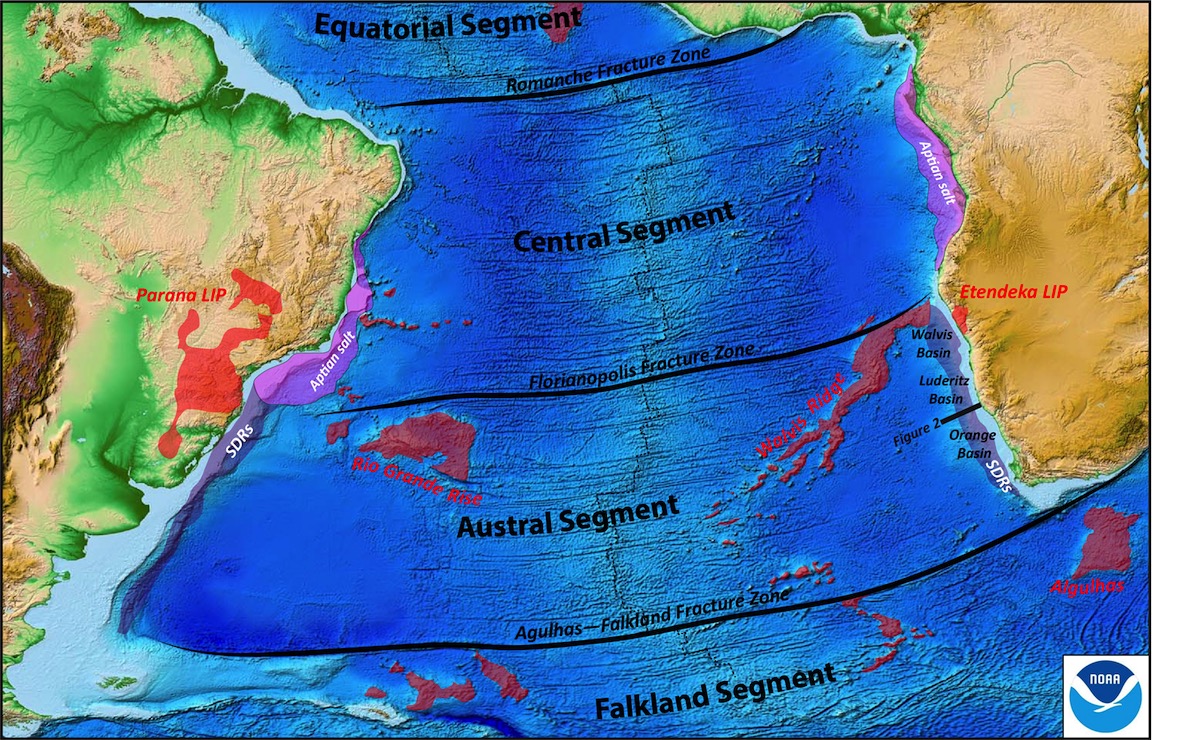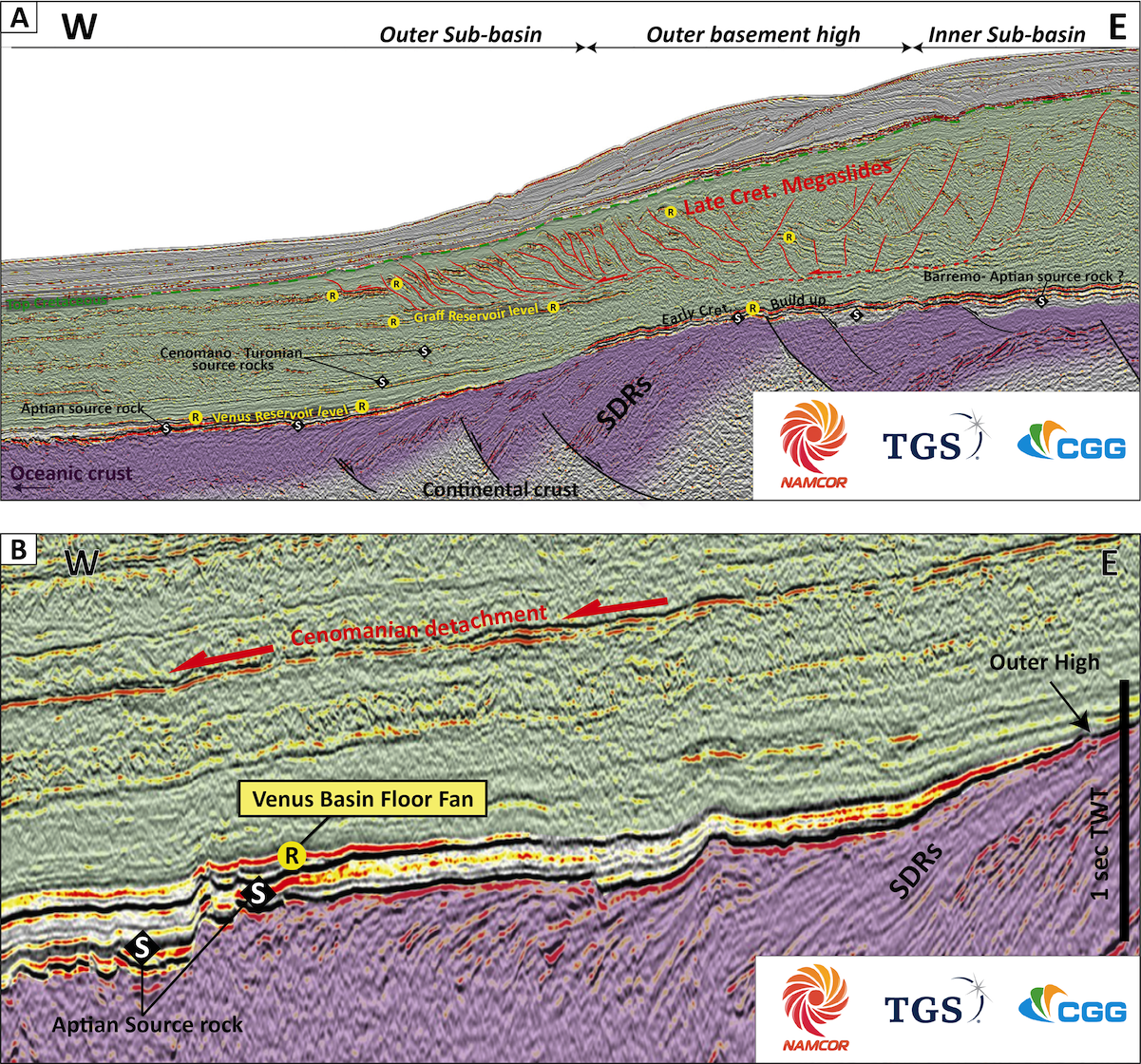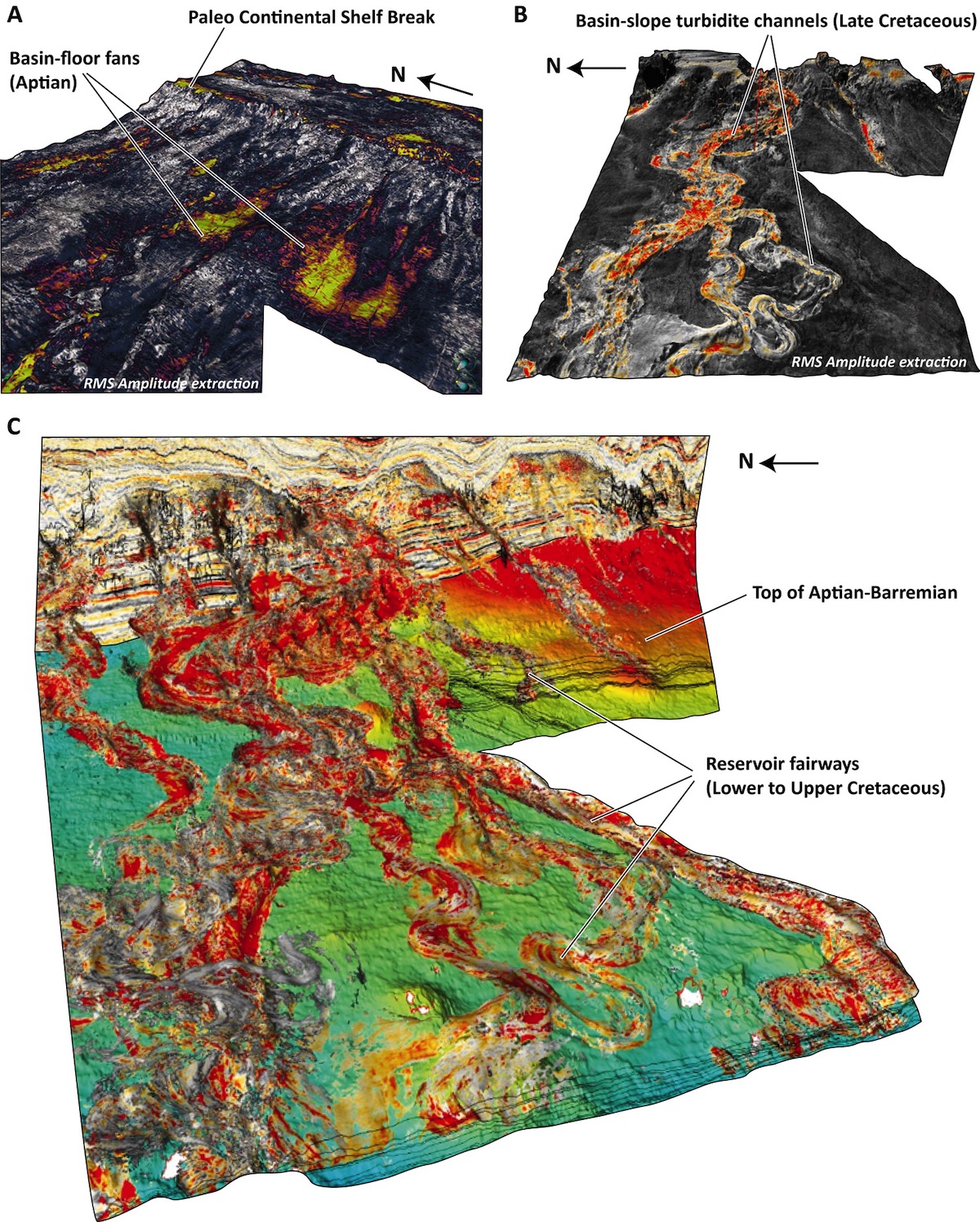South Atlantic Austral Segment: the new exploration hotspot?

A new perspective for the Orange Basin and its surroundings
The Namibian and western South African margins are Africa’s new exploratory frontier regions in deep and ultra-deep waters where hydrocarbon exploratory potential is justified by recent discoveries in nearby countries. The South Atlantic Austral segment is located between the Agulhas-Falkland and Florianopolis Fracture Zones (Figure 1), as the result of the southwest Gondwana break-up and subsequent seafloor spreading. The southwestern African margins were subdivided into three sub-basins, called Walvis, Luderwitz and Orange basins from North to South respectively. All of them remained under-explored areas for the last decades, by opposition to the rich and prolific oil provinces further north (e.g. Aptian Salt Basin, Niger Delta..). The South Atlantic Austral margin was a proven gas-prone province since the discovery of the Kudu field fifty years ago, and oil discoveries (2022 & 2023) in the Orange Basin recently revived the its prospectivity.
Regional setting
The South Atlantic Austral segment is characterized by volcanic, or magma-rich, rifted margins (Figures 1 & 2) (Chauvet et al., 2021 ; Sapin et al., 2021). Both South American and African conjugate passive margins are characterized by significant magmatism at least partly contemporaneous with the development of the Paranà - Etendenka Large Igneous Provinces (PE-LIP) (Gibson et al., 2006). Thick subaerial flood basalts, interbedded with sediments and paleo-soils in large rift-related half grabens, developed during the continental rifting until the oceanic seafloor spreading, from 135 Ma further South to 128 Ma further North (Hall et al., 2018). Those packages are imaged in seismic as seaward dipping reflector units (SDRs), typically wedge-shaped thickening seaward. The syn-rift depositional environments are predominantly terrestrial, ranging from fluvial, lacustrine and aeolian (Figure 3).

After the continental break-up, around 130 – 127 Ma, a classical oceanic crust emplacement emphasized the drifting between the two newly formed geodynamic plates. The post-rift succession is mainly composed of several open-marine depositional sequences that recorded the cooling of the newly accreted crust, the margin thermal subsidence, few inner margin uplifts and the sediment distribution along the margin (Figures 2 & 3, e.g. Scarselli et al., 2016). The visible variations of geomorphologies and sequences thicknesses within and between basins can be explained by significant sediment input variations. Locally, at their thickest part the SDRs may formed a NNW – SSE Outer High basement ridge that subdivided the margin along-dip into an inner and an outer sub-basins (Figure 2), developed during Neocomian and Aptian respectively. A restricted marine environment until Aptian allowed good quality source rock deposition prior to the connection with the global ocean.

Following the early Aptian flooding event, carbonate platforms developped locally above the outer high and surroundings (Intawong et al., 2019), then an aggradational marine sequence was deposited over the whole margin. From Albian to Turonian, a siliciclastic shelf prograded as a result of massive and continuous terrigenous sediment input (Séranne and Anka, 2005). Late Cretaceous sediments prograded across the shelf and were deposited on the slope and continental rise while the innermost shelf was partly eroded. Such large volumes of terrigenous sediments were derived from the coastal watersheds of Namibia, where up to 3 km of denudation were achieved during the Late Cretaceous (Gallagher and Brown, 1999). Denudation and uplift are also associated with episodic gravitational collapses with up-dip extensional and down-dip contractional domains. Those mechanisms may lead to the formation of hydrocarbon traps along the margin (McDermott et al., 2015). Gravity tectonics is also assisted by several Late Cretaceous décollements levels (Figure 4A) and possibly overpressured shale detachment layer (De Vera et al., 2010).
During the Cenozoic, the sedimentation thickness was reduced by half in comparison with Late Cretaceous values due to the onset of arid conditions during Neogene (Séranne and Anka, 2005). Paleocene fans draped over structural highs and slope failures, and Cenozoic morphologies were designed by shelf erosion, canyon incision, sediment by-pass on the shelf, and turbidite deposition on the slope. Prograding clastic wedge is affected by slumps and mass transport deposits, reworked by bottom currents in Oligocene with reorganisation of the ocean circulation.
Major discoveries and new wells insights
The first Namibian offshore exploration well was drilled in the Orange Basin in 1974. Three source rocks intervals between Barremian to Early Aptian ages were intersected in Kudu 9A-1 Well, deposited in an upper slope or outer shelf environment under poorly oxygenated conditions, and directly overlie volcanics, shallow marine shelly sands and aeolian sandstones. The Kudu gas field discovered at a depth of 4400m consists of a significant gas accumulation (1,3 TCF) within these Barremian aeolian volcanoclastic sandstone reservoir interbedded with basaltic lavas (Wickens & McLachlan, 1990).
-1200-9999.png)
Despite a string of unsuccessful drilling campaigns offshore Namibia since the Kudu discovery, interest in exploration has remained strong. In the early 2010’s, several exploration wells in the Walvis Basin (e.g. Wingat-1 and Murombe-1) and the Orange Basin (Moosehead-1, Kabeljou-1) contributed to de-risk main play elements despite no commercial discoveries (Hodgson & Intawong, 2013). They highlighted the presence of a mature Aptian source rock (~200 m thick), also encountered in other wells drilled along the Namibian and South African margins, including DSDP 361. Mooshead-1 and Kabeljou-1 also highlighted the presence of a marine Cenomanian – Turonian source rock in the Orange Basin, that may correspond to the Mid-Cretaceous Oceanic Anoxic Event. However, none of them encountered good quality reservoirs.
Until 2020, only 16 exploration wells and 8 appraisal wells (Kudu gas field) were drilled along the whole Namibian margin, and the Kudu gas field was still the only commercial discovery.
Over the past few years, new discoveries confirmed that oil generation is effective in the basin. In February 2022, two ultra-deepwater wells were drilled in the Orange Basin, revealing evidences of oil accumulation in sufficient quantity for commercial purpose. TotalEnergies made a significant discovery of light oil in the Venus prospect (Figure 4). The Venus-1X well encountered approximately 84m of net oil, with both reservoir and source rock likely of Aptian age.. The reservoir consists of a basin floor fan sitting directly on the source rock to the west, and onlapping the outer high to the east. The same month, Shell also made a significant discovery the Graff prospect (Figure 4A). The Graff-1 well encountered approximately 60m of net oil in Campanian - Santonian high quality slope channel of a turbiditic system. It’s likely probable that the light oil was generated in the Lower Cretaceous (Aptian-Barremian) or potentially older, deeper source rocks. More recently in March 2023, a third commercial scale oil discovery was announced in the Orange Basin by partners Shell, QatarEnergy and NAMCOR at the well Jonker-1X. Communications revealed that an Upper Cretaceous clastic reservoir pinches out up-dip below a Mass Transport Complex.

Hydrocarbon play elements
Exploration in frontier basins relies on geological interpretation but also on leveraging what information is available. In the light of recent discoveries, new plays concepts are emerging with more dataset to explore trapping mechanisms and source rock modelling (see Hedley et al., 2022). Below is a summary of the different elements of petroleum systems in place.
A second younger marine oil-prone source rock of Cenomanian-Turonian age was drilled with several wells in the Walvis and Luderitz basins (i.e., 1911/10-1, 1911/15-1 and 2012/13-1 wells) and in the Orange Basin (Mooshead-1 and Kabeljou-1 wells). It is embedded to a gravity-controlled mega-slide and is associated with a down dip contractional domain zone and overpressured detachment. Such overpressure is likely related to hydrocarbon generation and resulted in the reduction of shear strength of shales. This assumption is supported by vitrinite reflection from Turonian shale detachment in the Orange Basin, which indicates that these sediments entered the oil window during Santonian age (Hirsch et al., 2010), according to basin models with different heatflow gradients (Intawong et al., 2015).
Older source rocks are also possibly present but have yet to be proven by offshore wells. A syn-rift lacustrine oil-prone interval of Hauterivian age was proven in the most southern part of the Orange Basin, offshore South Africa. Nevertheless, this source rock remains to be drilled and tested along the margin.
Reservoirs
Early Cretaceous clastic plays encompass late syn-rift to early post-rift sequences from Barremian to Aptian age. It consists of continental and shallow marine clastic deposits (fluvial/aeolian/deltaic sandstones), locally interbedded with sub-aerially extruded volcanics. Seismic interpretation shows a strong along-dip and along-strike variability of the distribution of these sequences, due to the structural control during their deposition. These sandstones constitute the reservoir of the Kudu gas field, but they remain still largely untested at the margin scale. Outboard of the Outer High, marine clastics (i.e. Aptian basin floor) were positively tested recently on the Venus prospect.
Early Cretaceous carbonate sequences developed during Aptian and Albian age are intimately linked to the structures and geometries of the SDRs in the Luderitz and Orange Basins (Intawong et al., 2019). The carbonate build-up reefs are possibly developed all the way along the Outer High and inner sub-basin, and because they could offer large structural closures, they were primary targets for several wells along the margin. Nevertheless, well results highlighted that most of them have poor to no reservoir properties due to a lack of primary or secondary porosity (e.g., Wingat-1, Moosehead-1, Kabeljou-1 wells). As suggested by MacDermott et al. (2015), a rapid subsidence of the basin margin after the main periods of magmatic activity may prevent sub-aerial exposure of the carbonate platforms and as such precluded the development of secondary porosity. These carbonate plays are still poorly understood and a more regional study at the margin scale may offer other play opportunitie.
Late Cretaceous deep marine clastics revealed good reservoir properties and recent wells have tested them positively in varying ages. Thick Cretaceous good reservoir quality sandstones were penetrated in the Murombe-1 well, and the recent discoveries in Graff-1 and Jonker-1X wells are also located in Late Cretaceous turbiditic channels. The Late Cretaceous gravitational collapse structures likely controlled the turbiditic channels distribution (Figure 5) and provide important trapping and reservoir systems along the whole margin. A regional scale mapping, including sediment input points (the Orange River to the south, and the Ugab and Kunene Rivers to the north) and the up-dip erosional history will contribute to reduce the deep marine clastic plays uncertainties. The reservoir potential of Cenozoic clastics has yet to be proven, but insights and outcome from previous well campaigns are encouraging.

Concluding remarks
With each well drilled and new discoveries, the deepwater of Namibia and South Africa is progressively drifting away from risks and uncertainties of an underexplored area. Successful drilling campaigns are coming with deepwater exploration technologies advances and geoscience knowledge building. Two main oil-prone source rock systems were identified and tested as Barremian-Aptian restricted marine and Cenomanian-Turonian marine organic shales rich. The reservoirs include Barremian-Hauterivian aeolian sandstones interbedded with volcanoclastics and shaly limestones, Aptian basin floor fans, and sandy turbiditic channels in the post-rift sequences.
The passive nature and low amount of faults mean that structural traps are generally not easily found, and most traps are of stratigraphic nature although several large four-way dip closures are likely present in the Cretaceous megaslides system. To facilitate the investigation of the distribution of plays and traps along the southwestern margin of Africa, PaleoscanTM provides an interpretation platform useful in such context where the detailed understanding of clastic deposits distribution is fundamental. PaleoScanTM powerful autotracking algorithm converts all seismic reflections into horizons and stratigraphically organizes them. Eliis offer many tools from seismic data screening to reservoir characterization that can bring new insights in stratigraphic trap plays areas.
Acknowledgements
We would like to thank Chariot Energy Group for their authorization to publish results and figures on their Namibian margin dataset performed with PaleoScanᵀᴹ, during an exploration and drilling campaign on the Namibian margin (2018).
References
CGG (2022). Congratulations to TotalEnergies and all parties involved on the significant discovery at the Venus-1X well in Offshore Namibia. [Tweet, 2022 2 March]. Twitter
Chauvet, F., Sapin, F., Geoffroy, L., Ringenbach, J. C., & Ferry, J. N. (2021). Conjugate volcanic passive margins in the austral segment of the South Atlantic–Architecture and development. Earth-Science Reviews, 212, 103461.
De Vera, J., Granado, P., & McClay, K. (2010). Structural evolution of the Orange Basin gravity-driven system, offshore Namibia. Marine and Petroleum Geology, 27(1), 223-237.
Gallagher, K., & Brown, R. (1999). The Mesozoic denudation history of the Atlantic margins of southern Africa and southeast Brazil and the relationship to offshore sedimentation. Geological Society, London, Special Publications, 153(1), 41-53.
Gallagher, K., & Brown, R. (1999). The Mesozoic denudation history of the Atlantic margins of southern Africa and southeast Brazil and the relationship to offshore sedimentation. Geological Society, London, Special Publications, 153(1), 41-53.
Hall, S. A., Bird, D. E., McLean, D. J., Towle, P. J., Grant, J. V., & Danque, H. A. (2018). New constraints on the age of the opening of the South Atlantic basin. Marine and Petroleum Geology, 95, 50-66.
Hirsch, K. K., Scheck-Wenderoth, M., van Wees, J. D., Kuhlmann, G., & Paton, D. A. (2010). Tectonic subsidence history and thermal evolution of the Orange Basin. Marine and Petroleum Geology, 27(3), 565-584.
Hedley, R., Intawong, A., Winter, F., & Sibeya, V. (2022). Hydrocarbon play concepts in the Orange Basin in light of the Venus and Graff oil discoveries. First Break, 40(5), 91-95.
Hodgson, N., & Intawong, A. (2013). Derisking deep-water Namibia. first break, 31(12).
Intawong, A., Huuse, M., Rodriguez, K., Hodgson, N., & Negonga, M. (2015). Further de-risking source rock maturity in the Luderitz Basin using basin modelling to support the BSR-derived near-surface geotherm. first break, 33(10).
Intawong, A., Esestime, P., & Rodriguez, K. (2019). Observed link between folded Seaward Dipping Reflectors (SDRs) and large-scale morphology and architecture of the Early Cretaceous carbonate build-up and platform in the Orange Basin. First Break, 37(2), 63-68.
McDermott, K., Gillbard, E., & Clarke, N. (2015). From Basalt to Skeletons - The 200 million-year history of the Namibian margin uncovered by new seismic data. First Break, 33(12).
Sapin, F., Ringenbach, J. C., & Clerc, C. (2021). Rifted margins classification and forcing parameters. Scientific Reports, 11(1), 1-17.
Scarselli, N., McClay, K., & Elders, C. (2016). Seismic geomorphology of Cretaceous megaslides offshore Namibia (Orange Basin): insights into segmentation and degradation of gravity-driven linked systems. Marine and Petroleum Geology, 75, 151-180.
Séranne, M., & Anka, Z. (2005). South Atlantic continental margins of Africa: a comparison of the tectonic vs climate interplay on the evolution of equatorial west Africa and SW Africa margins. Journal of African Earth Sciences, 43(1-3), 283-300.
Winter, F., Intawong, A., and Robinson., J. (2022). The Orange Basin – An Underexplored Oil Giant?. GEOExPro. https://geoexpro.com/the-orange-basin-an-underexplored-oil-giant/
Wickens, H. D., & McLachlan, I. R. (1990). The stratigraphy and sedimentology of the reservoir interval of the Kudu 9A-2 and 9A-3 boreholes. Geological Survey of Namibia Communications, 6, 9-23.

